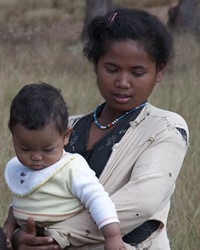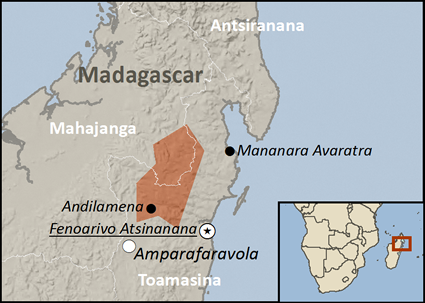The Sihanaka are known as the people of the swamps. Most live in the marshlands around Lake Alaotria, located in central northeastern Madagascar. European visitors in 1667 reported the Sihanaka had fortified villages which they effectively used to defend themselves. Living close to the main trade route between the capital of the neighboring Merina people and the port of Tbamasina allowed the Sihanaka to become wealthy traders in slaves and other goods during most of the 17th century.
At the turn of the 19th century, they came under the control of the Boina Kingdom. The was followed later when the Madagascar Merina people conquered them. When the Merina King Radama 1 allowed Christians into the country, there were several attempted to reach the Sihanaka. In 1897 the French conquered and colonized the island. The Sihanaka suffered in 1910 when the French forced them to build a railroad linking the coastal port of Toamasina to the capital city. This was known as corvee (statue labor) and the Sihanaka receive almost no pay as they were told the labor was a requirement, like paying taxes.
In 1960 the French surrendered its hold on Madagascar. With the new independence the Sihanaka began to practice intensive agriculture especially growing rice and vanilla. In order to do this, they have had to drain large parts of the swamp. This has allowed them to regain their honor and wealth.
With the use of heavy machines, the Sihaaka work hard to gain more land for farming. This has brought considerable criticism from people who were concerned about the natural habitats that are unique to the area especially the Lac Alaotra bamboo lemur. Being efficient hunters, they supplement their diet, which contains large amounts of rice, with wild game such as boars, lemurs, snakes, owls and an occasional crocodile. Tobacco, marijuana and pork are basically forbidden. They believe that if pigs were transported across Lake Alaotra to their villages bad storms would follow. Their traditional dress consisted of clothing woven of raffia fibers.
Parents were and are traditionally responsible for educating their own children especially when it comes to the social and cultural norms and practices. Those who can afford it will send their children to schools for formal education. Building their houses is achieved through the work of both men and women. The men construct the frame of the house, roof, windows and doors. Women weave the zozoro reed to make mats that cover the walls, flooring and roofs. One particular taboo that is practiced by all Sihanaka is not working in a paddy field on Tuesdays.
They are known and united by their traditional religious beliefs. Like other Madagascar people groups they acknowledge a creator god (Zanahary), their ancestors, and strong taboos (fady). By the 1600s the Sihanaka adopted 11 gods into their belief system. These god idols were given sacrifices and the people maintained specific prayers to them for various needs and protections in their lives.
Aspects of ancestor worship among the Sihanaka include joro (collective prayers said to invoke the blessings of God or the ancestors), burial in family tombs, reburial ceremonies of their dead and the sanctification of particular stones, land and shrines. Each family has their own elaborate burial space or house outside the village which is usually made of stone. They honor their dead as they believe the dead has a particular spirit that can at will possess them and placed them into a trance. If this ancestor spirit is angry this could cause them to suffer. If they want answers to problems the spirit will give them advise while in the trance. Communities look to ombiasy (wise men) for spiritual guidance, to commune with the ancestors, and to determine which days are auspicious for undertaking particular tasks or endeavors. When the Sihanaka were reached by missionaries in the mid to late 1800s (mainly French Catholics) a number became Christian believers. Often, they mixed their traditional spiritual beliefs with Christianity. Today, traditional beliefs remain strong among the Sihanaka, although a growing number practice orthodox Christianity. Some maintain a form of spiritual worship which blends their traditional beliefs with Christianity.
The Sihanaka need to be reached by committed evangelicals so they will know the power of the Lord's grace, love and commandments for living. They need the routine of Church, Bible study, prayer and the tools for discipleship that will be the most effective in reaching their people.
Pray for trained Christian workers to commit themselves with God-defined goals to reach the Sihanaka.
Pray for well-developed Bible training schools for Christian Sihanakas.
Pray that all tools including radio broadcasts, JESUS Films, youth programs and community outreaches will unite these people for God's kingdom.
Scripture Prayers for the Sihanaka in Madagascar.
| Profile Source: Joshua Project |

























